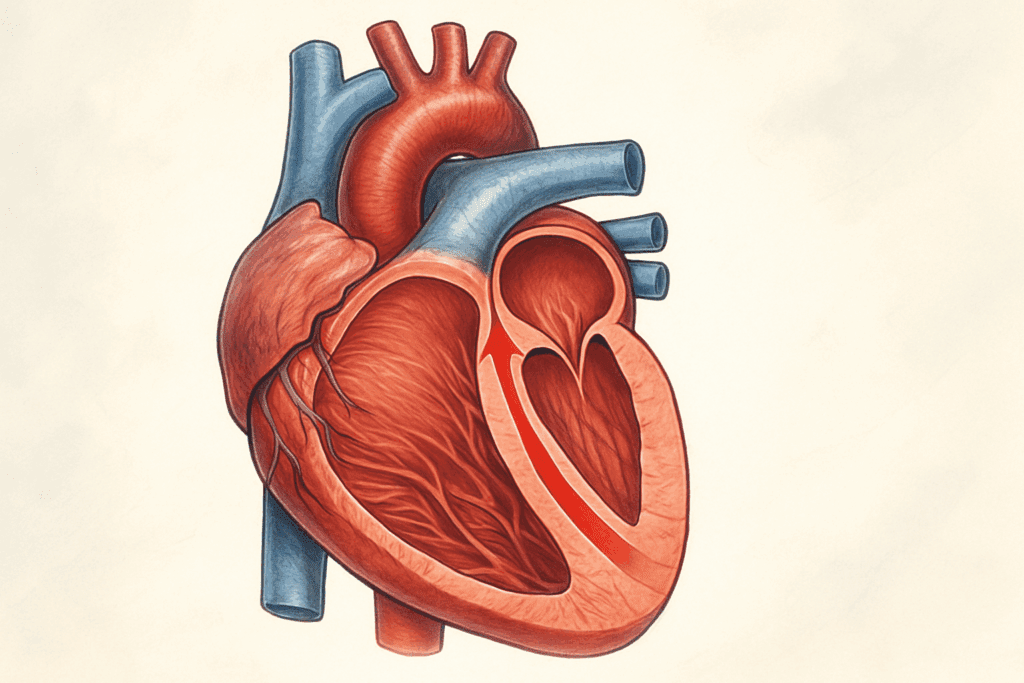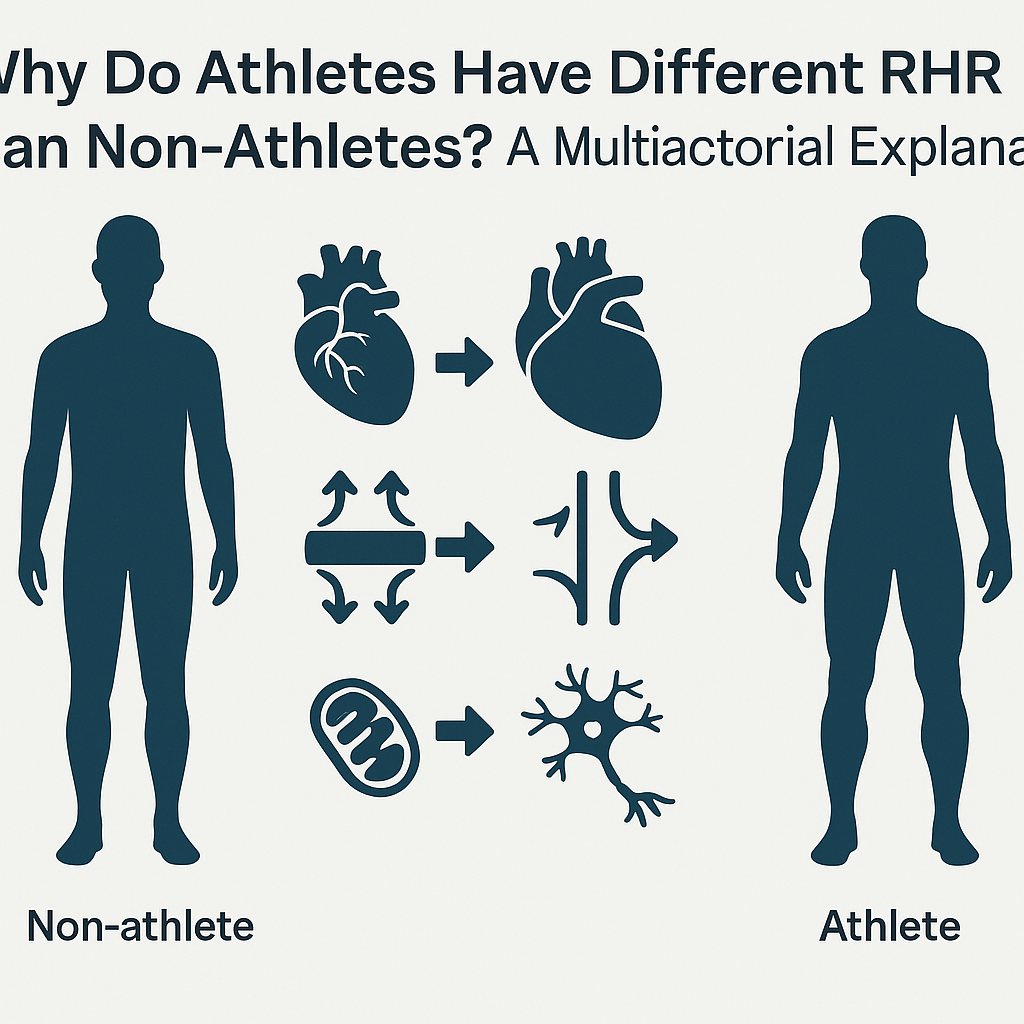Introduction: Understanding the Athletic Edge in Heart Rate
One of the most striking physiological differences between trained athletes and the general population is the heart rate measured at rest. For many, a resting heart rate (RHR) in the 60s or 70s is considered normal. Yet, for endurance athletes and high-performance competitors, resting heart rates in the 40s or even high 30s are not uncommon. This phenomenon raises compelling questions: Why do athletes have lower resting heart rates? What does this say about their cardiovascular health, stamina, and training outcomes? And is a lower resting heart rate always better? Exploring these questions offers fascinating insight into the powerful adaptations of the human body in response to consistent training and endurance conditioning. The athlete resting heart rate becomes not just a number but a reflection of health, longevity, and performance potential.
You may also like: Smart Nutrition Choices for a Healthier Lifestyle: What to Know About Whole Grain Rice and Whole Wheat Rice

The Physiology Behind a Lower Athlete Resting Heart Rate
At the core of understanding athletic heart rate is the heart itself—an organ that, when trained effectively, becomes more efficient at pumping blood. With long-term aerobic training, the left ventricle of the heart enlarges, allowing more blood to be ejected with each contraction. This increased stroke volume means the heart doesn’t need to beat as often to supply the body with adequate oxygen. As a result, the athlete pulse rate drops, and a lower resting heart rate is established. Athletes’ pulse rate at rest reflects not a weakness but a powerful adaptation—one that enhances oxygen delivery while reducing cardiac strain.
Such cardiovascular remodeling is most evident in endurance athletes, such as runners, cyclists, swimmers, and rowers. These individuals consistently demonstrate a runner’s resting heart rate or average athlete heart rate that falls well below what is considered normal for the general population. In fact, resting heart rate in the 40s is often viewed as a marker of elite conditioning. The consistent exposure to cardiovascular demand allows for more efficient nutrient and oxygen transport during both rest and exercise, a hallmark of sport heart rate adaptations.
Is a Lower Resting Heart Rate Better? Performance and Recovery Implications
When considering whether a lower resting heart rate is beneficial, it’s important to recognize context. In trained individuals, particularly athletes, a lower heart rate generally indicates efficient cardiovascular function. It suggests that the heart can pump sufficient blood with fewer beats, conserving energy and allowing for quicker recovery between bouts of exertion. This is one of the key benefits of low heart rate in athletes—it supports sustained activity and faster return to baseline after intense workouts or competition.
The normal heart rate of athletes, when observed in relation to the heart rate chart by age and gender, consistently skews toward the lower end. In some elite cases, the average heart rate for athletes at rest falls into the upper 30s, while still supporting high-intensity performance. This discrepancy when compared to sedentary individuals—whose RHR may be 70–80 bpm—highlights how different the cardiovascular systems of trained athletes truly are. Indeed, one of the reasons why athletes have lower heart rates is that their systems have adapted to prioritize oxygen efficiency and resilience to fatigue.

Training Intensity and Its Role in Athlete Pulse Rate Adaptation
Not all athletes exhibit the same resting heart rate levels, and that variation is tied directly to the type, duration, and intensity of their training. Endurance athletes, in particular, demonstrate the most significant reductions in resting heart rate due to the prolonged and rhythmic demand placed on the cardiovascular system. A marathon runner, for instance, may have a significantly lower athlete resting HR than a sprinter or strength-based athlete. The runner’s resting heart rate often reflects the repetitive aerobic conditioning that reshapes both the heart’s structure and function.
High-intensity interval training (HIIT) and long-distance endurance sessions alike contribute to adaptations that lower resting heart rate over time. This transformation is not immediate—it occurs progressively, requiring consistency and adequate recovery. In this sense, the athlete’s pulse rate at rest is not only a signal of current fitness but also a summary of months or even years of disciplined training. The benefits of low heart rate become evident in both performance enhancement and long-term health, offering athletes a valuable physiological advantage.

Monitoring and Understanding Sport Heart Rate Variability
The sport heart rate is more than just a measure of beats per minute; it’s a dynamic metric that can reveal how well an athlete is recovering, how their body is responding to training, and whether they are at risk of overtraining. Monitoring heart rate—both at rest and during activity—allows athletes and coaches to make informed decisions about training loads, recovery days, and intensity adjustments. A sudden spike in athlete resting heart rate, for example, may indicate illness, overtraining, or insufficient sleep.
Wearable technology has made it easier than ever to track the normal pulse rate in athletes. Devices like heart rate monitors, smartwatches, and recovery trackers provide real-time data on resting heart rate trends, sleep quality, and variability. Understanding these metrics in context—especially when compared to heart rate charts by age and gender—can help athletes fine-tune their routines for optimal results. Importantly, consistent tracking helps detect anomalies that could signal health concerns, thus reinforcing why the average pulse rate for athletes is a key performance and health metric.

Athletic Heart Rate and the Bigger Picture of Cardiovascular Health
Beyond performance, a low resting heart rate in athletes is associated with a reduced risk of cardiovascular disease, hypertension, and arrhythmias. This is due in part to the reduced workload on the heart over time and improved vascular elasticity. A slower heart rate means fewer contractions over the course of a lifetime, which can decrease wear and tear on the cardiovascular system. For this reason, the benefits of low heart rate are not limited to peak performance years but extend into long-term health outcomes.
However, not every case of a low heart rate should be taken as a sign of health. In non-athletes, especially those experiencing fatigue, dizziness, or fainting, a very low resting heart rate may indicate an underlying condition such as sick sinus syndrome or other forms of bradycardia that require medical attention. This distinction is crucial. While a resting heart rate in the 40s is common and normal for an elite endurance athlete, it may not be appropriate for someone without that level of training. Understanding why an athlete has a lower resting heart rate, and what it means in the context of training, helps avoid misinterpretation of health data.

Psychological and Neurological Advantages of a Lower Resting Heart Rate
The athlete resting HR also reflects a calm and well-regulated nervous system, particularly the parasympathetic branch. This is the system responsible for rest, recovery, and digestion. An efficient autonomic nervous system supports mental clarity, emotional regulation, and better sleep—all crucial components of athletic success. Many elite athletes report that a consistently low resting heart rate correlates with feelings of calm, control, and readiness to perform.
Neurological advantages go beyond stress management. When the body is not constantly in a high-alert state, it conserves energy and promotes more efficient focus during competition. This is another reason why athletes have lower resting heart rates—it’s not just a cardiovascular adaptation but also a nervous system one. Athletes with lower pulse rates often experience enhanced recovery from both physical and mental exertion, contributing to better resilience across all domains of performance.

Why Do Athletes Have Different RHR Than Non-Athletes? A Multifactorial Explanation
The question “do athletes have different RHR compared to others?” is best answered through a multifactorial lens. It’s not simply about exercise volume; it’s about how the body adapts on multiple levels. The heart enlarges, vascular resistance decreases, mitochondrial efficiency improves, and the nervous system adapts to sustain prolonged effort. Each of these adaptations contributes to the athlete resting heart rate and supports performance gains across disciplines.
When comparing the normal heart rate of athletes to the general population, the difference is clear and consistent. Factors such as gender, age, genetics, hydration, altitude exposure, and even emotional state all play a role, but training remains the dominant driver. From a sports science perspective, these insights emphasize why continuous monitoring and targeted training matter. Understanding the average heart rate for athletes at rest is not just a medical or fitness curiosity—it’s a cornerstone of performance optimization.
Frequently Asked Questions: Athletic Heart Rate and Resting Heart Rate Insights
1. Can a lower resting heart rate in athletes affect performance in high-intensity sports like sprinting or weightlifting? Yes, but not in the way many assume. While a lower athlete resting heart rate is often associated with endurance sports, it can still benefit those in high-intensity disciplines. A lower baseline heart rate allows athletes to manage cardiovascular stress more efficiently, even during anaerobic bursts. Although sprinters and power athletes may not have as low an athlete pulse rate as distance runners, their sport heart rate profile still reflects superior recovery capability. That quicker recovery is critical between sets or rounds, making the benefits of low heart rate relevant across athletic domains.
2. How does altitude training impact the athlete resting heart rate and long-term cardiovascular adaptations? Altitude training stimulates physiological changes that can lower the athlete resting heart rate over time. By exposing the body to lower oxygen levels, the cardiovascular system is forced to increase red blood cell production and oxygen-carrying capacity. As athletes return to sea level, these adaptations enhance aerobic efficiency, often reflected in reduced athletes pulse rate at rest. This technique is frequently used by elite endurance athletes aiming to drop their runners resting heart rate further. The improved blood oxygenation and heart efficiency contribute to a stronger athletic heart rate response during competition.
3. Why do athletes sometimes experience elevated resting heart rates during periods of heavy training? Despite typically having a low average athlete heart rate, intense training blocks can temporarily elevate RHR. This rise in athlete resting HR is often due to accumulated fatigue, dehydration, or inadequate sleep. It’s an early warning sign of overreaching or overtraining. Monitoring sport heart rate metrics during these times can help athletes and coaches decide when to adjust training volume. A sudden deviation from a normal heart rate of athletes signals the need for strategic recovery interventions.
4. Do younger athletes always have lower resting heart rates compared to older athletes? Not necessarily. While younger individuals may start with a higher maximum heart rate due to age-related norms (as seen in a heart rate chart by age and gender), their average heart rate for athletes at rest can still vary. The key determinant is training age—how many years someone has trained consistently—not just biological age. A 40-year-old endurance athlete may have a lower athlete pulse rate than a 20-year-old recreational runner. The normal pulse rate athletes display reflects both cardiovascular efficiency and the cumulative impact of consistent aerobic training over time.
5. How does heart rate variability (HRV) relate to the average pulse rate for athletes? Heart rate variability and average pulse rate for athletes are interlinked but offer distinct insights. A low resting heart rate in the 40s may indicate high aerobic fitness, but HRV reveals how well the body responds to stress and recovers. Higher HRV usually accompanies a lower athlete resting heart rate, indicating parasympathetic nervous system dominance. This means the body is not only fit but also resilient. Monitoring both HRV and the athlete resting HR can offer a comprehensive picture of physical readiness and recovery trends.
6. Can an athlete’s low resting heart rate affect them during medical procedures or hospital visits? Absolutely, and it often causes confusion. Medical staff unfamiliar with athletic physiology may interpret an athlete resting heart rate in the 40s as bradycardia requiring intervention. This misunderstanding can lead to unnecessary tests or concerns. It’s crucial for athletes to inform healthcare providers of their athletic status to contextualize their athletic heart rate. Understanding why athletes have lower heart rates can prevent misdiagnosis and ensure appropriate care.
7. What psychological factors can influence the athlete resting heart rate or sport heart rate? Psychological stress plays a significant role. Even with a well-conditioned heart, anxiety, competition nerves, or poor sleep can raise the athlete pulse rate at rest. Mental fatigue impacts autonomic regulation, potentially affecting the normal pulse rate athletes usually exhibit. Techniques like mindfulness, meditation, and breathing exercises can help regulate the athletic heart rate. By managing mental stress, athletes can maintain their average heart rate for athletes at rest more consistently.
8. Are there differences in resting heart rate between male and female athletes? Yes, but the variation is nuanced. While both genders can achieve a resting heart rate in the 40s with training, females often have slightly higher heart rates due to smaller stroke volume and different hormonal profiles. However, with equivalent training and conditioning, the average athlete heart rate among women can approach male counterparts. Heart rate chart by age and gender data reveals this subtle variation, but it does not imply lower fitness levels. Instead, it reflects physiological diversity in how athletes’ pulse rate at rest adapts.
9. Can endurance training lower resting heart rate too much or pose risks? For healthy athletes, a low athlete resting heart rate is generally not dangerous. However, in rare cases, resting heart rate in the 40s or lower may cause symptoms like dizziness or fainting, especially if there’s underlying heart conduction dysfunction. It’s essential to distinguish between athletic adaptation and pathological bradycardia. If an athlete develops new symptoms, it’s wise to get a cardiac evaluation to rule out issues unrelated to training. Still, the average heart rate for athletes at rest is usually a sign of efficient heart function, not a cause for concern.
10. How can recreational athletes track improvements in their athlete resting HR over time? Using wearables or chest-strap heart rate monitors, recreational athletes can log their morning resting heart rate daily. Over weeks or months, a gradual decrease in athlete resting HR indicates improved cardiovascular conditioning. Comparing these numbers against a heart rate chart by age and gender can provide context, but trends matter more than single readings. As training progresses, a lower average athlete heart rate and more stable athletes pulse rate at rest reflect growing endurance capacity. Tracking these metrics becomes a motivational tool and a checkpoint for balanced training.
Conclusion: The Athletic Pulse—A Reflection of Performance, Health, and Resilience
The athlete’s resting heart rate tells a compelling story of human potential. It reflects the intricate adaptations that occur in response to persistent training, intelligent recovery, and high-performance demands. Whether examining the average pulse rate for athletes, exploring why athletes have lower resting heart rates, or understanding how a resting heart rate in the 40s supports endurance, the message is consistent: a lower heart rate in athletes is a sign of strength, not weakness.
Athletes who learn to listen to their heart rate gain a competitive edge. It helps them avoid overtraining, enhance recovery, and maximize efficiency during training and competition. But perhaps more importantly, it becomes a lifelong marker of health. From runners’ resting heart rate metrics to team athletes optimizing their recovery with heart rate variability, this data empowers informed, precise, and individualized strategies for success.
The next time you check your pulse and notice it’s lower than average, consider the bigger picture. If you’ve trained diligently, fueled your body well, and allowed for proper recovery, your athletic heart rate may be telling you that you’re on the right path—not just toward peak performance, but toward lasting cardiovascular health. The benefits of low heart rate, when understood and harnessed, truly reflect the brilliance of the athletic body in motion and at rest.
Was this article helpful? Don’t let it stop with you. Share it right now with someone who needs to see it—whether it’s a friend, a colleague, or your whole network. And if staying ahead on this topic matters to you, subscribe to this publication for the most up-to-date information. You’ll get the latest insights delivered straight to you—no searching, no missing out.
Further Reading:
Why Do Athletes Have a Lower Resting Heart Rate?
Why do athletes have low resting heart rates?
Disclaimer
The information contained in this article is provided for general informational purposes only and is not intended to serve as medical, legal, or professional advice. While NewsHealthWatch strives to present accurate, up-to-date, and reliable content, no warranty or guarantee, expressed or implied, is made regarding the completeness, accuracy, or adequacy of the information provided. Readers are strongly advised to seek the guidance of a qualified healthcare provider or other relevant professionals before acting on any information contained in this article. NewsHealthWatch, its authors, editors, and contributors expressly disclaim any liability for any damages, losses, or consequences arising directly or indirectly from the use, interpretation, or reliance on any information presented herein. The views and opinions expressed in this article are those of the author(s) and do not necessarily reflect the official policies or positions of NewsHealthWatch.

